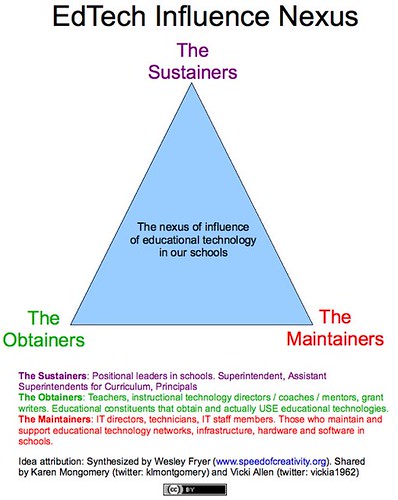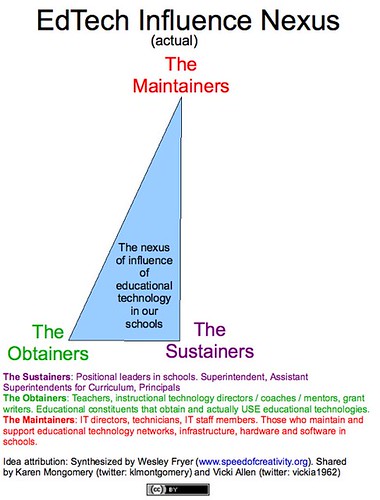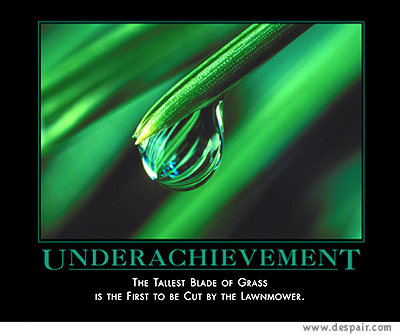I had a thought provoking conversation recently with Karen Montgomery about some terms and dynamics relating to educational technology in our schools. Vicki Allen had shared this after talking to a Tandberg system engineer. In our schools, we have “obtainers” and “maintainers” when it comes to educational technologies. The obtainers are teachers, instructional technology directors / coaches / mentors, and grant writers. Educational constituents that obtain and actually USE educational technologies fit into the “obtainer” category. These are the end users.
Another group is “the maintainers.” These are IT directors, technicians, and other IT staff members. Those who maintain and support educational technology networks, infrastructure, hardware and software in schools are the “maintainers.” Often the priorities, success metrics, and even values of the “obtainers” versus the “maintainers” are quite different.
In talking with Karen about this, I realized there is a third group which is essential in the nexus of influence which develops within school cultures relating to educational technology use and non-use. This group might be called “the sustainers,” borrowing from a Six Sigma term. (Thanks to Karen for this reference.) The sustainers are the positional leaders in schools. The superintendent, assistant superintendents for curriculum, and campus principals are all sustainers. These are the people in positional authority roles.
I created the following graphic to help illustrate the nexus of influence between these three groups: The sustainers, the obtainers, and the maintainers of educational technologies in schools:
In many, many cases in my experience, among these groups it is the MAINTAINERS who have the most power and influence over how educational technologies actually get used or not used in our schools. Are all wikis blocked on the district content filter? Is skype blocked? Is videoconferencing readily available and useable by teachers for virtual guest speakers and classroom exchanges? Are teachers permitted to access outside email accounts from school? I am not laying the “blame” for technology non-use in our schools entirely on the shoulders of “the maintainers” because I recognize there are a variety of outside inputs and influences maintainers are responding to (legal requirements and mandates being one) but I do think this is NOT an even power balance in most schools. In my experience it is the “maintainer” group which has vastly more control, authority and influence over technology decisions and district policies. The “sustainers” may have the positional authority, but they most often defer to the recommendations of the “maintainers” rather than the “obtainers” when it comes to technology decisions. Perhaps this diagram more accurately represents the ACTUAL, relative power distribution in this nexus of influence:
This framework for thinking about educational technology policies at the district and campus levels reminds me of several things. Going back ten years, it reminds me of my TechEdge article in 1998-1999 “Wagging the Dog in Educational Technology:
Elevating ‘IT’ Into the Classroom.” As an “obtainer” in my school district as a 4th grade teacher, pointing out some conflicts between the worldview and operational priorities/policies of our districts’ “maintainers” was NOT well received by the “sustainers.” There is more to that story that I have never told publicly before. For now I will simply share the following “Underachievement” slogan: “The tallest blade of grass is the first to be cut by the lawnmower.” The price of public dissent in a public school can be high.
The second thing I’m reminded of is some sessions and conversations from NCCE 2008 in Seattle. My presentation “Lead Differently – Digitally Informed School Leadership for the 21st Century” addressed these issues. It also reminds me of my podcast interview with Julia Fallon (titled “Building Bridges for Conversation Between IT and Instructional Leaders in Washington Schools”) at the NCCE 2008 conference. That podcast description was/is:
Instead of sponsoring separate technology leadership summits for IT and instructional administrators this year, NCCE conveners (including Julia) coordinated a joint leadership summit. This provided an excellent opportunity, through panel discussion and small group breakout sessions, to build bridges for conversations between educational leaders in these different areas. In this interview, Julie discussed the formative results of the 2008 NCCE leadership summit as well as the outstanding work being supported through educational technology grant initiatives in the state of Washington. Educational leaders in other parts of the United States should follow the lead of NCCE and Washington department of education leaders in fostering these critical conversations between different educational leadership groups. Our educational system has many goals, and to insure groups within it are not working at cross-purposes regular communication is vital. Julia and others in Washington are working to capture video vignettes of innovative educational technology projects in their state which will be showcased online later this year. Kudos to these educational leaders in the state of Washington for their leadership in fostering these conversations between IT and instructional administrators, and making plans to follow-up on those conversations in the months ahead!
Conversations like that one facilitated at NCCE between maintainers, obtainers, and sustainers are essential for school communities to constructively address the dynamics (which are often dysfunctional) of this influence nexus when it comes to educational technologies.
NCCE member-readers: Does anyone know the status of that video vignette project?
For anyone: What do you think of this “nexus framework” using maintainers, obtainers, and sustainers as categories to help us explore, understand, and improve communication between those constituents who influence educational technology use and non-use in our classrooms? Do you know of other examples at local, state, regional or national levels where sustainers, maintainers, and obtainers are coming together at a common table to have discussions about educational technology use and non-use issues?
Technorati Tags:
technology, education, school, leadership, nexus, conversation, ncce, ncce08, sustainer, maintainer, obtainer, edtech, influence, influencer
If you enjoyed this post and found it useful, subscribe to Wes’ free newsletter. Check out Wes’ video tutorial library, “Playing with Media.” Information about more ways to learn with Dr. Wesley Fryer are available on wesfryer.com/after.
On this day..
- Introducing Students to Dangers of Deepfake Videos – 2019
- Disclosure Statements, EdTech Ambassador Programs and Digital Citizenship – 2017
- Join Free @STEMseeds Webinar Saturday Sept 13th at 10:30 am Central – 2014
- Long Term Sub Needed: Positive Tomorrows of Oklahoma City – 2014
- iOS Content Creators Rejoice: iMovie, Pages, Keynote and More FREE on New Devices! – 2013
- Why Playing with Media and Mapping Media Matters – 2013
- Encouraging Pre-Service Educators to Share Work Publicly Online – 2012
- Lessons Learned from WordPress Blog Upgrades – 2012
- Using Film in Any Class – 2011
- Criteria for moderating comments on a viral video – 2009




Comments
4 responses to “The Educational Technology Influence Nexus”
Dean Mantz suggested via a tweet the term “containers” rather than “sustainers.” That can certainly be appropriate as well. Dean wrote:
I think that this is really an important issue. In our forward thinking and rich district we still have this issue. Part of the problem (?) is that the Obtainers often hold knowledge (how Novell works) that the others do not have. This can be used as a reason for the control. It might even be a good reason, but it is hard to tell. Communication is really the key…
It all hinges on trust for all three groups and communication is central to that!
Janice
I’m not sure I am comfortable with the terms used for these three groups, but for discussion’s sake…
I think you are letting the “sustainers” off the hook. The problem you describe is their responsibility. Administrators should not take this from technical people. They need to insist that the IT crew speak in the vernacular, and make decisions that support teachers and students to do the work of education.
Of course, many times the “obtainers” demand capabilities that IT simply cannot provide. IT crews in K-12 are short handed, and often lack sufficient resources to deliver the expected services. In this case also, the primary weight falls on the administrator (“sustainer,” in your terms.)
For many years we have described these problems with ICT in educational environments. I understand that IT people can be ornery, but in my opinion, the primary barrier is still administrator competency.
[…] skrifaði nýlega eftirtektarverðan pistil um upplýsingatækni í skólastarfi á vef sinn Moving at the Speed of Creativity. Viðfangsefnið er velþekkt en vanrækt að ég tel, þ.e misskipting áhrifa og valds þeirra […]